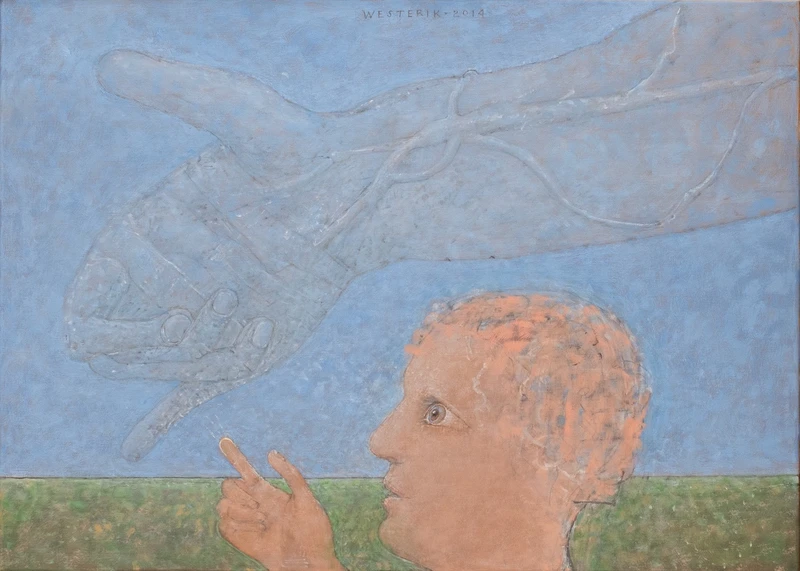Co Westerik: Centenary
14 Nov 2023-27 Jan 2024
PV 14 Nov 2023, 6-8pm


On the centenary of his birth, Sadie Coles HQ presents an exhibition of paintings and related works on paper by the Dutch artist Co Westerik (1924-2018). Covering the period between 1974 to 2016, the body of work centres the human figure as its subject matter, revealing Westerik’s conviction that painting itself is an act of probing inner life.
The solo show conveys the artist’s measured application of oil paint and tempera, enabling slow revelations about the subject. While Westerik’s works have become synonymous with touch and intimacy, typified by his previous solo exhibition at Kingly Street and his retrospective at the Museum Boijmans Van Beuningen, both in 2019, this anniversary presentation gives way to a more uncompromising, and at times unsettling, encounter with the body.
The artist’s practice invokes a tradition of Dutch Realism as much as it can be situated in the canon of more experimental post-war figurative painters, such as David Hockney, Francis Bacon and Philip Guston. The work holds realism and more quixotic forms in tension, which lends a singularity to Westerik’s entire practice. In the painting’s fresco-like appearance, a paradox is revealed in illuminating ways. The attention to surface and texture belies the artist’s intent to get behind the subject and reveal the human interior.
People are frequently, but not exclusively, seen alone in this selection of works; in each case, there is a distinct feeling of distance, or of psychological dysmorphia. Intimacy is replaced with something transactional and detached, leaving the artist’s audience in the uncomfortable position of voyeur. In Contact (2014) a child extends a finger cautiously toward a large, translucent, spectral hand in the sky, the apparitions smallest digit extended in return: the protagonist is about to connect with the supernatural. It is unclear whether it is a delusion, an angel or something more sinister. Within the exhibition space the self appears in more material ways, too. The lone body collapsed into a partially abstracted pile, or a bust in nature amongst plants and tools.
Doctor and Patient (2014) depicts a scene of examination, the figures’ physical entanglement with one another rendered ambiguous, returning to a common questioning of power dynamics, identifiable throughout the artist’s corpus, often with occupational authority figures. This suspicion is reinforced by the inclusion of early works, such as Intense Summer Event (1998), where inscrutable figures are replaced by partial torsos, only visible from behind, their lower halves transformed, or transfixed, into tree trunks. With a title that alarmingly understates the facts, bodies are illustrated in unnatural forms with ominous undertones, yet portrayed in shared mortal companionship on a summer’s day, under a picturesque blue sky and large white clouds.
Westerik kept detailed journals throughout his life, unveiling the motivations behind his creative process, writing: ‘The guiding principle of my work has been to create a sensible image that would encapsulate a state of mind, averse to any decorative intent. Probing even further, deeper than visually perceptible. A process of revelation, an expedition in search of territory deep down, with its promise of greater truth’. The works in Centenary are depictions of interior life made legible by the relationship between the self and all it encounters. Westerik’s oeuvre prefigures ideas of confrontation as a way to examine the self; a kind of disenchantment, a kind of self-othering that enables internal examination into this ‘greater truth’.
Co Westerik (b. 1924, The Hague, d. 2018) studied at the Academie van Beeldende, the Hague, graduating in 1947. From 1958 to 1971 he worked as a teacher of life drawing at the academy. From 1971, he worked from Rotterdam and the south of France. His oeuvre spans painting, drawing and etching. In 1999 he was made a Knight of the Order of the Netherlands Lion. Recent posthumous solo exhibitions include body and landscape, Sadie Coles HQ, Davies Street, London (2019); and Everyday Wonder, Museum Boijmans Van Beuningen, Rotterdam (2019). His work has featured in recent group exhibitions including The Main Entrance, Shahin Zarinbal, Berlin (2022); The Holding Environment, Chapter I and The Holding Environment, Chapter II, Bonner Kunstverein, Bonn (2021).